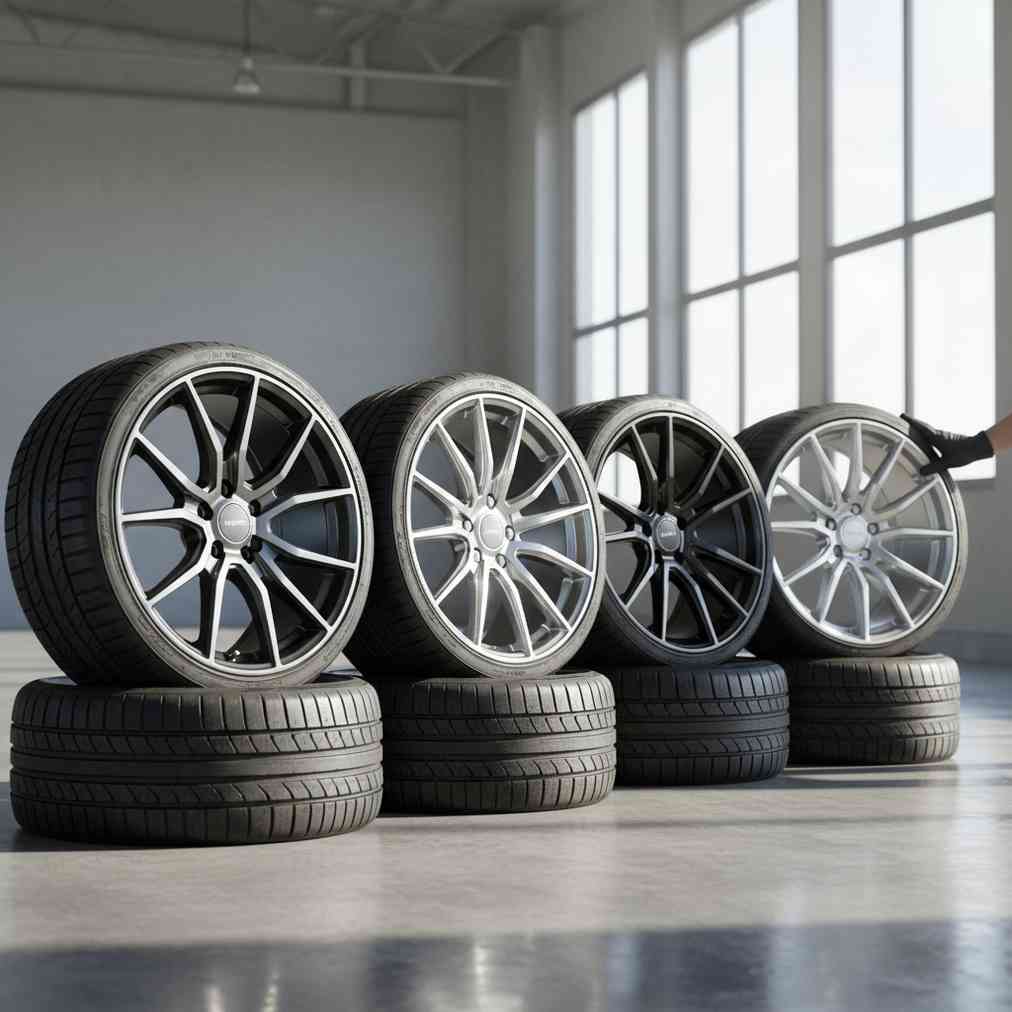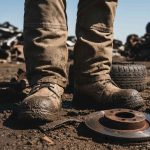Safe Removal Techniques for Wheels, Tires, and Rims
Removing wheels, tires, and rims from junk cars requires proper tools, safety precautions, and systematic approaches to maximize both safety and profit potential. Whether you’re working at a junkyard near me or processing vehicles in your own salvage operation, understanding the correct removal techniques is essential.
Essential Tools and Equipment
Before beginning the removal process, gather the necessary tools to ensure efficiency and safety:
- Breaker bar with appropriate socket sizes for lug nuts
- Battery-powered impact wrench for stubborn or seized lug nuts
- Cheater pipe for additional leverage when needed
- Reciprocating saw or angle grinder with cutting wheels
- Pry bars and crowbars for wheel removal
- Protective equipment: gloves, safety glasses, and dust masks
- Towels or rags to protect wheel finishes during removal
Step-by-Step Wheel Removal Process
The wheel removal process begins with accessing and loosening the lug nuts. Expert junkyard visitors recommend using a long breaker bar with proper leverage, especially when working without the benefit of vehicle brakes being engaged.
For seized lug nuts, apply penetrating oil and allow it to work for several minutes before attempting removal. If lug nuts remain stuck, a battery-powered impact wrench often provides the necessary torque without requiring excessive physical effort.
Tire and Rim Separation Methods
Once wheels are removed from the vehicle, separating tires from rims requires different approaches depending on available tools and desired outcomes:
| Method | Tools Required | Time Investment | Best for |
|---|---|---|---|
| Manual Removal | Pry bars, screwdrivers | 5-10 minutes per tire | Preserving both tire and rim |
| Power Tool Cutting | Angle grinder, reciprocating saw | 1-2 minutes per tire | Quick aluminum rim recovery |
| Bead Breaking | Specialized tire machine | 2-3 minutes per tire | Professional operations |
The manual tire removal method involves deflating the tire completely through the valve stem, then working pry tools around the rim to break the bead seal. While time-consuming, this approach preserves both components for potential resale.
For faster processing when focusing on aluminum rim recovery, power tools offer significant time savings. Cutting across the tire tread and slicing the bead allows quick tire removal, though this method renders tires unsuitable for resale.
Comprehensive Condition Assessment
Accurate condition assessment determines the difference between valuable resale components and scrap material. This evaluation process requires systematic inspection of both wheels and tires to identify their market potential.
Wheel and Rim Inspection Criteria
Professional wheel assessment focuses on both structural integrity and cosmetic condition. Critical structural issues that immediately disqualify wheels from resale include:
- Hairline cracks or visible fractures anywhere on the wheel
- Significant bends that affect wheel balance or tire seating
- Corrosion damage that compromises wheel strength
- Missing chunks or pieces from the wheel structure
- Warping that prevents proper tire mounting
Cosmetic damage affects resale value but doesn’t necessarily eliminate sales potential. Minor curb rash, surface scratches, or faded paint may reduce selling price while still maintaining structural viability for budget-conscious buyers.
Tire Condition Evaluation
Tire assessment requires examining multiple factors that affect safety and performance:
- Tread depth measurement using a tread depth gauge or penny test
- Sidewall inspection for cuts, bulges, or embedded objects
- Age assessment using DOT date codes (tires over 6 years may have limited appeal)
- Wear pattern analysis indicating potential vehicle alignment issues
- Dry rot or cracking that suggests tire deterioration
Tires with tread depth above 4/32″ and no significant sidewall damage typically maintain resale value, while those below 2/32″ may only retain scrap material worth.
OEM vs. Aftermarket Identification
Distinguishing between Original Equipment Manufacturer (OEM) wheels and aftermarket alternatives significantly impacts resale value. OEM parts typically command higher prices due to guaranteed fitment and manufacturer quality standards.
OEM wheels feature specific part numbers, manufacturer markings, and design elements that match original vehicle specifications. These characteristics make them particularly valuable to buyers seeking exact replacements or maintaining vehicle authenticity.
Market Value and Pricing Analysis
Understanding current market values helps optimize pricing strategies and identify the most profitable components for salvage operations.
| Component Type | Condition | Typical Price Range | Market Demand |
|---|---|---|---|
| Steel Wheels | Good condition | $25 – $75 each | Moderate |
| Aluminum Wheels | Excellent condition | $50 – $200+ each | High |
| OEM Wheels | Good to excellent | $100 – $300+ each | Very High |
| Used Tires | Good tread remaining | $25 – $75 each | High |
| Scrap Aluminum | Any condition | $0.50 – $1.50 per lb | Stable |
Recent market trends show increased demand for affordable OEM components as vehicle repair costs continue rising. This trend particularly benefits salvage operations focusing on popular vehicle models and high-quality wheel sets.
Strategic Resale Channels and Platforms
Successful wheel and tire resale requires matching products with appropriate sales channels based on condition, type, and target market demographics.
Online Marketplace Strategies
Digital platforms offer extensive reach but require strategic presentation and pricing approaches:
- eBay: Ideal for rare or specialty wheels with detailed photos and comprehensive descriptions
- Facebook Marketplace: Excellent for local sales with pickup options, reducing shipping complexities
- Craigslist: Effective for bulk sales or complete wheel sets to local buyers
- Specialized automotive forums: Target specific vehicle communities for OEM parts
Success in online sales requires high-quality photographs showing all angles, detailed condition descriptions, and competitive pricing based on current market research.
Local and Regional Sales Options
Regional sales channels often provide faster turnover with reduced shipping complexities:
- Auto salvage yards purchasing inventory for resale
- Independent tire shops seeking quality used components
- Automotive repair facilities serving budget-conscious customers
- Car enthusiast meetups and swap meets
- Scrap metal dealers for damaged or unsellable wheels
Specialized Tire and Wheel Buyers
Several companies specialize in purchasing used tires and wheels for retreading operations or resale to specific markets. These buyers often provide:
- Bulk purchasing options for large quantities
- Standardized grading systems for consistent pricing
- Regular pickup schedules for ongoing operations
- Immediate payment upon inspection and acceptance
Benefits of Junkyard OEM Wheel Purchases
Understanding why customers choose used OEM wheels helps salvage operators position their inventory effectively and identify high-value components during processing.
Cost Advantages for Buyers
Used OEM wheels from junkyards provide substantial cost savings compared to dealership prices, often available at 60-80% below new retail costs. This pricing advantage makes them attractive to:
- Budget-conscious vehicle owners needing single wheel replacements
- Insurance companies seeking cost-effective repair solutions
- Auto repair shops serving price-sensitive customers
- Classic car enthusiasts maintaining period-correct appearances
Guaranteed Fitment and Quality
OEM wheels eliminate fitment concerns that commonly affect aftermarket alternatives. Customers value the assurance that manufacturer specifications will match their vehicle requirements exactly, including:
- Bolt pattern compatibility
- Load rating specifications
- Offset and backspacing measurements
- Center bore diameter
- TPMS sensor compatibility
This guaranteed compatibility reduces return rates and increases customer satisfaction, making OEM wheels particularly valuable in salvage operations.
Advanced Salvage Techniques and Tips
Professional salvage operators employ specific techniques to maximize efficiency and component value during wheel and tire processing.
Maximizing Aluminum Recovery Value
Aluminum wheel processing focuses on metal purity and weight optimization. Recent increases in aluminum scrap prices make tire removal increasingly profitable, with clean aluminum commanding premium rates at scrap facilities.
Experienced scrappers report that removing tires before selling aluminum wheels can increase profits by 200-300% compared to selling complete wheel assemblies.
TPMS Sensor Recovery
Modern vehicles equipped with Tire Pressure Monitoring System (TPMS) sensors present additional value opportunities. These sensors, typically valued at $50-$150 each when functional, require careful removal to avoid damage during tire separation.
TPMS sensors are particularly valuable for vehicles manufactured after 2008, when federal regulations mandated their inclusion in all passenger vehicles.
Bulk Processing Considerations
Large-scale tire removal operations benefit from systematic approaches that balance speed with component preservation. Professional operations often invest in:
- Dedicated tire removal stations with proper ventilation
- Blade inventory management for power tool operations
- Component sorting systems for different material types
- Safety protocols for handling cutting tools and debris
Safety Considerations and Best Practices
Safe wheel and tire removal requires attention to multiple hazard categories and proper protective equipment usage throughout the process.
Personal Protection Equipment
Essential safety equipment includes:
- Safety glasses with side protection against metal and rubber debris
- Cut-resistant gloves for handling sharp metal edges
- Dust masks when using power cutting tools
- Steel-toed footwear for protection against dropped wheels
- Hearing protection during extended power tool use
Environmental and Health Considerations
Power tool cutting generates sparks, metal particles, and rubber fumes that require proper ventilation and waste management. Professional tire removal operations emphasize the importance of working in well-ventilated areas and disposing of tire debris responsibly.
Profitable Cash Opportunities
The wheel and tire salvage market offers multiple revenue streams that can significantly enhance salvage operation profitability. Understanding these opportunities helps operators maximize returns from each vehicle processed.
For those looking to sell a junk car rather than process individual components, many buyers offer competitive quotes that include wheel and tire values in their assessments. This option provides immediate cash flow without the time investment required for individual part sales.
Revenue Optimization Strategies
Successful wheel and tire operations employ several strategies to maximize profitability:
- Grade separation: Sorting components by condition and value potential
- Market timing: Understanding seasonal demand patterns for different tire types
- Volume pricing: Negotiating better rates with regular buyers
- Complete set premiums: Matching wheels and tires into complete sets
- Niche market targeting: Identifying specialized buyers for unique or rare components
The combination of increasing aluminum prices, steady demand for affordable vehicle repair solutions, and growing environmental consciousness creates a favorable market environment for professional wheel and tire salvage operations.
Conclusion
Successfully removing and selling wheels, tires, and rims from junk cars requires systematic approaches that balance safety, efficiency, and profit optimization. From proper removal techniques using appropriate tools to accurate condition assessment and strategic sales channel selection, each step contributes to overall operation success.
The growing market for affordable OEM components and increasing aluminum scrap values create favorable conditions for salvage operators willing to invest time in proper component processing. Whether focusing on high-value OEM wheel resale or bulk aluminum recovery, understanding market dynamics and customer needs enables sustainable profitability in this specialized segment of the automotive recycling industry.
By implementing the techniques, safety practices, and market strategies outlined in this guide, salvage operators can transform what might otherwise be overlooked components into significant revenue streams while contributing to sustainable automotive recycling practices.





Leave a Reply
You must be logged in to post a comment.